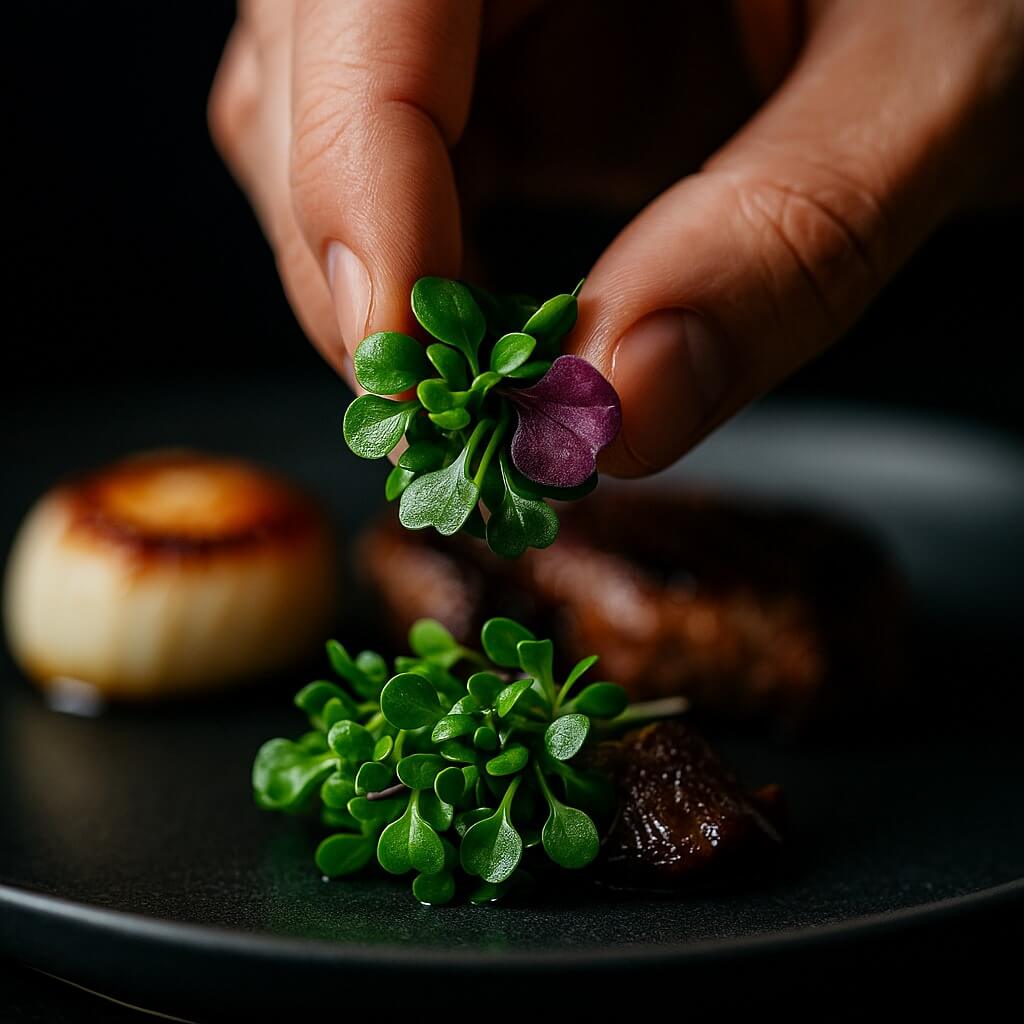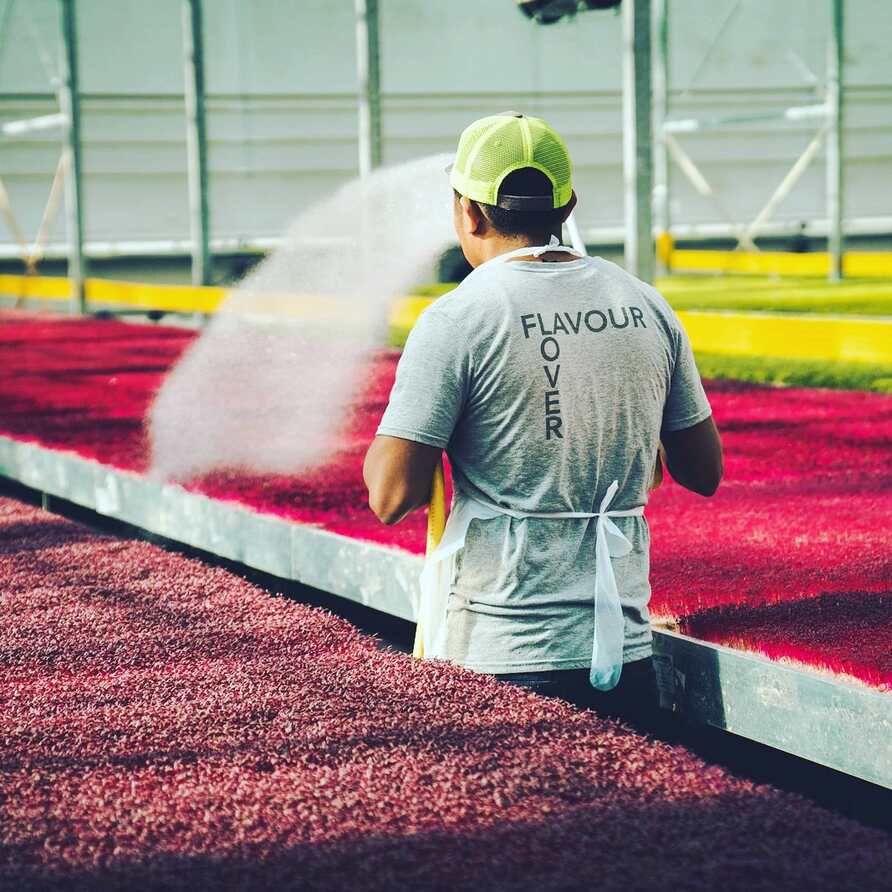May
26
Microgreens in NYC & Beyond: Grown to Finish Strong
What They Are — and Why They Matter
What are microgreens?
Microgreens are young vegetable greens harvested 7–21 days after germination, just after the first true leaves develop. Grown in soil or substrate, they’re packed with nutrients, intense flavor, and vibrant color — used by chefs to enhance both taste and presentation. Microgreens aren’t sprouts. They’re not baby greens either. They’re somewhere in between — young, vibrant greens harvested after the cotyledon stage. That means peak flavor, punchy color, and just the right structure to finish a dish with intent. You don’t use them for fluff. You use them because they finish strong.Microgreens vs. Sprouts: What’s the Difference?
Before we get into what microgreens are, let’s clear up what they’re not. Sprouts grow in water and are eaten whole, root included — risky and often soggy. Microgreens from many growers are soil-grown, but at Flavour Fields, our microgreens are grown hydroponically on a clean, natural fiber mat, ensuring they’re free from dirt and contaminants. This method delivers consistent, vibrant, and cleaner microgreens — perfect for chefs who demand quality and safety.- They’re trimmed above the root, full of color, texture, and flavor.
- They’re not a substitute — they’re an upgrade.
Not Sprouts. Not Baby Greens. Something Better.
Ours are hydroponically grown on a biodegradable natural fiber mat — no soil, no sludge, just structure, taste, and a clean conscience. Every tray is built to thrive in your kitchen’s rhythm.- Sprouts grow in water and you eat the root.
- Baby greens are oversized, floppy, and fade fast.
- Microgreens from many growers are soil-grown, snipped at their prime, and plated to impress.
Know Your Greens. Plate with Purpose.
Great microgreens start with the right plant family:- Brassicaceae – mustard, arugula, broccoli (bold, spicy)
- Apiaceae – celery, carrot, fennel (aromatic)
- Amaranthaceae – beet, amaranth (colorful)
- Asteraceae – lettuce, radicchio (crisp, bitter)
Top 5 Microgreens Chefs Reach For
Micro Broccoli
Crisp, subtle, reliable. Loaded with sulforaphane and always ready to add quiet balance to the bold.Micro Sunflower
Nutty, meaty, with enough structure to stand up on a warm plate. Smooth base? Add this.Micro Shiso Purple
Eye-catching. Herbaceous. Made for sashimi, tartare, or anything that needs a flavor flourish.Micro Basil Mix
Fragrant and bright. Think Italian meets Thai — and sometimes fusion finds its way to the plate.Micro Mizuna / Micro Mustard Red
Spicy brassicas with bite. Hit the fat. Cut the rich. And do it in color.Local-grown, because flavor moves fast..
Grown in Long Island using sustainable methods, our microgreens go from greenhouse to garnish without compromise — reducing transit time, maximizing shelf life, and delivering the punch chefs expect.Where the Right Chefs Get Their Greens
From high-end restaurants in Manhattan to boutique hotels in Texas — we’re already on the pass. Order direct. Use our cut microgreens or try our living trays. Either way: chef-ready, shelf-stable, and never basic.Finish Strong — Microgreens That Do More Than Look Good
You don’t just want pretty. You want purpose.- Shiso to brighten raw fish
- Basil to lift citrus
- Mustard to slap the fat off a short rib
- Sunflower to anchor soft textures
How to Grow Microgreens Step-by-Step
Want to grow your own? Here’s the breakdown:- Use shallow trays, good drainage, and fresh soil or growing mats
- Mist seeds daily until germination (2–5 days)
- Provide light — sunlight or LEDs, 12–16 hours a day
- Harvest around day 7–14, just after the first true leaves show
Nutrition That Works as Hard as You Do
You’re not selling vitamins. But you are selling intention. Our microgreens — like Micro Broccoli — bring sulforaphane, vitamins A, C, K, and fiber. Real nutrition chefs can stand behind, without sacrificing plate design. You’re not selling vitamins. You’re selling intention. Our microgreens — like Micro Broccoli — deliver concentrated nutrients like sulforaphane, vitamins A, C, K, and fiber. These dense greens provide a nutritional boost that supports wellness while enhancing the artistry of your plate. A 2023 study published in Nutrients highlights that microgreens are rich in bioactive compounds, including antioxidants and polyphenols, that may reduce oxidative stress and inflammation. This research confirms microgreens’ superior nutrient density compared to mature vegetables, making them a smart choice for chefs focused on flavor and health. Read the full study here For reliable nutrient data, visit the USDA FoodData Central, and for general vegetable nutrition insights, see the Harvard T.H. Chan School of Public Health.Health Benefits of Microgreens: Why Chefs Use Them
You’re not selling superfoods, but you’re serving wellness. Microgreens offer concentrated doses of antioxidants, vitamins A, C, and K, and fiber — especially varieties like broccoli, radish, and mustard. They elevate the dish and the story behind it.Safe. Fresh. Chef-Tested. Buyer-Approved.
Our microgreens are:- Grown in sanitized environments
- Packed cold
Everything You Didn’t Know You Needed to Know
Are Microgreens Healthy or Not?
Yes. Packed with antioxidants, vitamins, and functional flavor.Disadvantages of Microgreens
Microgreens are delicate and require careful handling to maintain their quality and freshness.What Are Microgreens Made Of?
Stems, cotyledons, and sometimes true leaves — harvested early and strong.How Do You Eat Them?
Raw, plated, blended. Add late to hot food or go bold on cold.Nutritional Benefits of Broccoli Microgreens
Sulforaphane. Vitamin C. Fiber. This isn’t just garnish — it’s functional flavor.What Are the Benefits of Microgreens?
- Nutritional density — more vitamins per gram than mature greens
- Visual appeal — color, texture, contrast
- Flavor impact — spicy, sweet, nutty, or bright
- Shelf-stable formats — cut or living trays to suit any line












